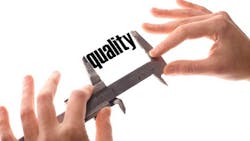What is the Continuum of Quality Management? (Part 1)
Business success depends on quality processes and outcomes at every level. Quality management ensures customer satisfaction, operational efficiencies, and increased revenue.
However, not all organizations use a cookie-cutter approach to quality management. Hence APQC wanted to understand the continuum of practices and interviewed eight organizations on the current state of their quality, process, and continuous improvement.
This two-part series explores the practices and structures for their continuous improvement (CI) and quality functions’:
- organizational structure,
- competence assurance,
- procedural adherence,
- continuous improvement,
- support for site-based workers, and
- measurement and key performance indicators (KPIs).
This first article looks at three of the practices and structures: organizational structure, competence assurance and procedural adherence.
Organizational Structure
The higher in the organization the CI and quality group resides, the higher the performance of quality measures. To understand organizations’ quality and continuous improvement structure, we asked: Where in the structure of the organization does the group(s) responsible for CI and quality reside. The results indicate a full spectrum of responses (Figure 1); the dots on the continuum represent where the participating organizations fall on the spectrum.
Competence Assurance
We know that organizations that work in highly technical, and often regulated industries, frequently develop enterprisewide competencies for staff. This increases the capabilities of the organization and helps ensure compliance to requirements. Participants were ask how they describe their competence assurance programs (e.g., training, skills, testing, and certifications) (Figure 2).
For example, one energy company’s centralized strategy execution team outlines a basic set of core competencies that align with the organization’s values. It then works with human resources and the BUs to develop competency standards and training for all major job functions. During performance review process employees are assessed against the 7 to 8 core competencies for each level within the organization. The competencies are actually behaviors that align with the organization’s values and role-specific tasks. To keep the training relevant all programs are assessed every two years to maintain accreditation. Though the core competencies and oversight come from leadership in training and operations, managers own their specific training programs and the training group provides facilitation.
Procedural Adherence
One of the biggest challenges of unified standards is making sure staff actually uses the standards in their daily jobs. Hence the participants were asked what activities did they use to ensure procedural adherence and which ones were successful (Figure 3).
Another energy organization took its procedural adherence program a step further and developed a behavioral tracking program that collects over 500 observations for each site on a weekly basis. In addition to observations of front-line workers, it also conducts “parent” observations where the supervisor and manager observe the employee; and the manager also monitors how the supervisor corrects and coaches employees on the job. The observations are documented and tracked in a central repository, which helps the organization analyze enterprisewide data for compliance, identify patterns, and predict future performance.
Conclusion
Generally speaking most organizations fall midway on the quality management continuum. Though the exact structures and practices vary most organizations are characterized by a federated model: governance and standardization, with execution and daily management decentralized within the BUs. The main differences between organizations occur between the level of executive involvement, the extent of a holistic approach, and breadth of their standards and practices.
Next time we will cover the last three practices: continuous improvement, support for site-based workers, and measurement and key performance indicators (KPIs).




